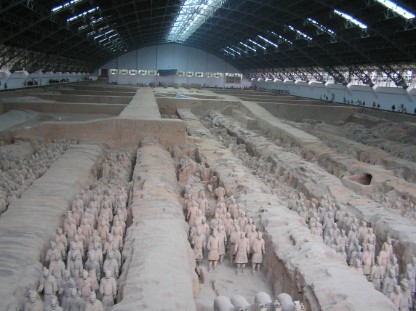
The Mausoleum of Qin Shi Huang Di, the first Qin emperor, is famous not because of its occupant, but because of his army. A terracotta army of 8,000 soldiers and horses, each delicately carved and unique, was made for him to take to the afterlife. There are vanguards, officers in chariots, and soldiers, aligned with the road to the mausoleum. Three real chariots made from bronze were also discovered, possibly for the Emperor to ride as he conquered the afterlife. Unfortunately, their weapons were stolen shortly after the death of Qin and their colors have faded with time.
The army was made around 210 B. C. and was discovered near Xi'an, Shanxi, by local farmers in 1974. They have different heights according to their role and were made from clay from Mt. Lishan. The heads, arms, legs, and torsos were all made separately and then assembled. Eight face molds were used to make the heads, with clay added to make them individual. The legs appear to have been made the same way as the terracotta pipes used at the time. The workshops that worked on the army can all be identified because it was required that workshops put their names on their work in order to ensure quality control.
There are three pits with soldiers. Pit 1 is 252 y. (230 m.) long, 68 y. (62 m.) wide, and 16 ft. (5 m.) deep and was the pit discovered in 1974. There are five entrances on the eastern and western sides and two entrances on the northern and southern sides, as well as one in the northeast corner leading into pit 3. There is a puddle wall every three y. (3 m.), separating the army into columns. The walls are fortified with wooden columns, earth, and reeds and the floor is covered with black bricks. The pit was destroyed at the end of the Qin dynasty by Xiangyu, and many soldiers and horses were crushed.
Pit 2 is 136 y. (124 m.) long, 107 y. (98 m.) wide, and 16 ft. (5 m.) deep and was found in 1976. There are two entrances on the northern side and four on the eastern and western sides. Pit 2 can be divided into 4 sections:
-
Section 1 is square-shaped and is in the eastern corner of Pit 2. There are four corridors with 60 crossbowmen standing in them. There are four east-west passageways with 160 crossbowmen squatting in them.
-
Section 2, on the right side of the pit, has 64 war chariots divided into 8 rows. Each chariot is pulled by four life-sized horses. There are three warriors side by side behind each chariot, with the middle one driving the chariot.
-
Section 3, in the center, has 264 foot soldiers and 8 cavalrymen, with 19 war chariots. Each cavalryman is in front of a horse with one hand drawing a bow and the other holding the reins. There are eight to thirty-six foot soldiers in each chariot.
-
Section 4, on the left side of the pit has three east-west passages which all the cavalrymen are aligned with.
The bronze swords in this pit are 34 in. (86 cm.) long and have eight symmetrical facets. They were coated with a 10 micron thick oxide film with 2% chrome. How this was done is a mystery as the techniques to do so was only discovered in modern times and requires a complex set of equipment and technological processes.
Pit 3 was found a month after Pit 2 and has an area of 520 m2. It has 68 warriors, 4 horses, and 1 chariot. There are animal bones and deer horns scattered on the floor, possibly for war rituals. This is probably the command center for the rest of the army.